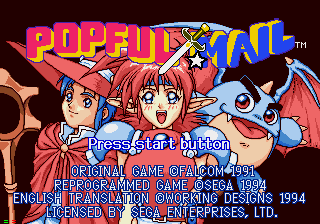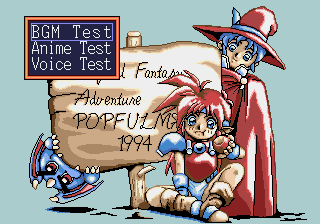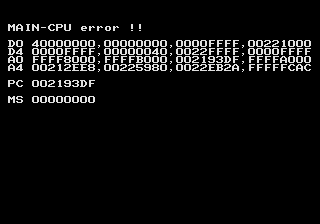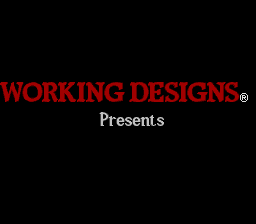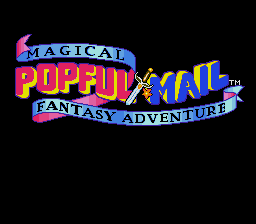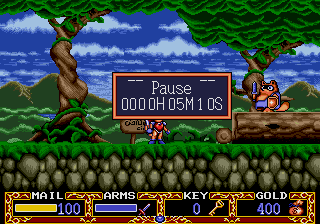Popful Mail (Sega CD)
| Popful Mail |
|---|
|
Developer: Nihon Falcom
|
Popful Mail for the Sega CD is a port/remake of Falcom's 1991 side-scrolling RPG for the PC-88. It would probably have remained Japan-exclusive had not Working Designs stepped in and given it a US release (and the less said of Sister Sonic, the better).
Working Designs also made sure that the word "biffed" remained strong in your memory. And made a few very small cosmetic changes. Just a few.
Contents
Text
The Japanese version of the game is peppered with various plaintext debug and error messages, e.g.
Not enough M-memory !
FILENAME is not defined
Illegal destination
in GM01.BIN.
Interestingly, most of these were commented out of the US version.
Test Mode
At the main menu, select Quit Game and leave "No" highlighted at the confirmation prompt. Then press Left, Right, Left, Right, Left, Right, Right, Right, A. The Utilities menu will now contain a new Test Mode option featuring a sound test, voice test, and cutscene viewer.
In the Japanese version, the code is instead Left, Right, Left, Right, Right, A. Since the Utilities menu doesn't exist there, the Test Mode option is in the main menu.
Crash Handler
The game has a basic crash handler that dumps the main CPU's registers in the event that something goes wrong. To see it, well, crash the game. In the Japanese version, overwriting byte 0x0C of GM00.BIN (which is at 0x11780C in an ISO) with 0xFF should make this show up after pressing Start at the title screen.
Regional Differences
It's that time again, folks: WORKING DESIGNS presents a Working Designs game performed by Working Designs featuring Working Designs developed by Falcom starring Working Designs. Lots of stuff got changed around for the US version, sometimes for good reason and sometimes decidedly not. Let's start with the more innocuous additions and work our way down.
Title Screen
The game's startup sequence was significantly altered for the US release.
In the Japanese version, the game always boots directly to the title screen. Idling there for long enough will play the game's opening cutscene. Pressing Start on the title screen leads to the main menu, and starting a new game from the menu leads directly to the world map.
In the US version, this is much more complicated:
- First of all, Working Designs' logo appears for a few seconds before the game begins.
- After the publisher logo, this new splash screen featuring the title logo shows up.
- The game then plays the first half of the original Japanese opening (the "legend") until it finishes or the player presses Start, then cuts to the title screen.
- In the Japanese version, the title screen is completely silent, but in the US version it's actually accompanied by a new track done by the American staff!
- Idling on the title screen does nothing.
- After pressing Start on the title screen, the game checks if any save files exist. If none do, it skips the main menu and immediately starts a new game.
- Whenever a new game is started, the game plays the second half of the original opening scene (Mail's pursuit of the Nuts Cracker).
Main Menu
| JP | US |
|---|---|
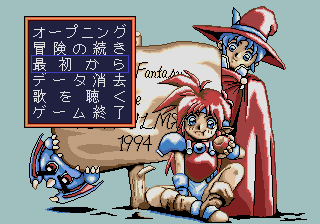 |
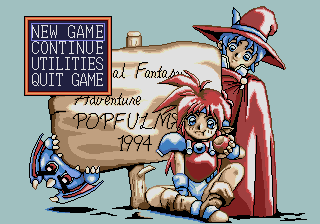 |
The US version significantly reworks the main menu, for whatever reason.
In the Japanese version, there are six options: Opening, Continue, New Game, Erase Data, Listen to Song, and Quit Game. Opening plays the game's opening, Erase Data deletes all the save data, and Listen to Song plays the game's vocal theme.
The US version reduces this to just New Game, Continue, a new "Utilities" option, and Quit Game. The Utilities submenu now contains the Delete Data option, as well as an extra "Options" menu. The Options menu itself is the same as the "BGM" menu accessible in-game.
| JP | US |
|---|---|
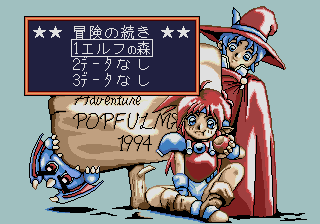 |
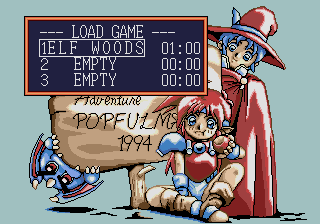 |
The US version reformats the Save and Load menus slightly so that they display the amount of time elapsed on each file. In both versions, the most recently saved file is selected by default when the menu is opened.
Additionally, the US version will automatically close the menu and return to the title screen if it's left idle for long enough.
Cutscenes
- The first part of the opening scene is actually significantly different in the US release. The Japanese version has written narration over each scene, but the US version erases the text entirely in favor of a voice-over by Mail.
- The US cutscenes have different music tracks from the Japanese version. Sometimes they're recreations of the originals using a different synthesizer, but in other cases (such as the second half of the opening, and the ending) the music has been completely rewritten. There's a good possibility that Working Designs didn't get the original backing tracks from Falcom, just the finished versions with baked-in Japanese voice-overs, and they ended up having to remake them from scratch in order to get the English dub in.
- The ending theme was rewritten into English. As with the cutscenes, the localizers apparently didn't have access to the original backing tracks; the English song has been recreated from scratch, resulting in very different instrumentation and mixing.
Gameplay
The US version alters the control scheme. In the Japanese version, B is jump while A and C both perform attacks (they're treated identically). The menu is opened with Start.
In the US version, A and B work the same, but C instead opens the menu.
Pressing Start now opens this new, animated pause screen, which keeps track of the time elapsed on the current file.
| JP | US |
|---|---|
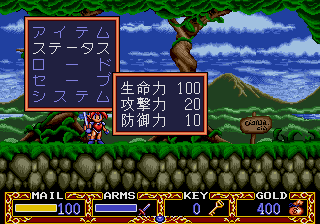 |
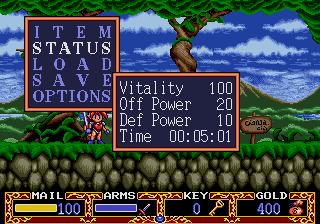 |
The Status subwindow has been expanded to incorporate the time elapsed on the current file. (All these time-related changes actually have a purpose – more on that later.)
Miscellaneous
- In the Japanese version, the clouds in the background of Elf Woods use a parallax scrolling effect, but only move when the player scrolls the screen. In the US version, they constantly move to the left independently of the screen's movement.
- The US version adds extra dialogue from the characters on the Game Over screen. This didn't exist at all in the Japanese release.
- The reason so many extra time displays were added around the game is a new feature added to the game: depending on how quickly it's beaten, a certain number of outtakes from the voice-over recording sessions are played after the "The End" screen. To hear them in full requires beating the game in under five hours.
- Oh, and it goes without saying, but a lot of the US script is made up. It's similar to Lunar: Eternal Blue, where the English dialogue was produced by some combination of exaggerations of the original lines combined with extra "jokes" or other innovations inserted by the localizers. Overall, it's perhaps a bit less severely mangled than some Working Designs games, if only because the original material wasn't very serious in the first place.
- On a related note, most of the English names are different, too (e.g. "Blackie" became "Slick", and "Material" became "Muttonhead").
Shop Prices
So everything up to here is pretty much window dressing and nice little bonuses, right? Added title music, extra secrets? Well, that's not the end of it.
To start with, the US version of the game inflates many items' prices by massive amounts. A prominent victim is the invincibility-granting Amulet, which costs a mere 100 Gold in the Japanese version but 1500 Gold in the US version. Or there's the Melon, which goes for 300 Gold in Japan but 1000 Gold in the States. The sell prices have mostly been increased too, but rarely by enough to make selling things actually useful. The sell price of Gold Bullion (which exists only to be sold) was actually slashed in half from 1000 to 500 Gold.
Generally, the idea seems to have been to make healing items and buffs much harder to get. A side effect of the repricing is that while all healing items have the same cost/restoration ratio in the Japanese version (3 Gold per HP restored, versus 4.5 Gold per in the US version), the US version actually makes the two highest-end items a worse value for the money (8.125 and 10 Gold per, for the Banana and Melon respectively). Since the lower-end items are easily obtainable by backtracking, this means it's a massive waste to buy those items in the US version!
The prices of weapons and armor were left alone.
| Item | Buy Price | Sell Price |
|---|---|---|
| Amulet | 100 -> 1500
+1400, 1400% |
10 -> 100
+90, 900% |
| Helmet | 150 -> 400
+250, 167% |
10 -> 50
+40, 400% |
| Stone Shoes | 100 -> 1000
+900, 900% |
10 -> 30
+20, 200% |
| Ice Shoes | 100 -> 250
+150, 150% |
10 -> 30
+20, 200% |
| Spiked Boots | 100 -> 500
+400, 400% |
10 -> 60
+50, 500% |
| Orange | 60 -> 90
+30, 50% |
10 -> 15
+5, 50% |
| Cherry | 120 -> 180
+60, 50% |
20 -> 30
+10, 50% |
| Apple | 180 -> 270
+90, 50% |
30 -> 45
+15, 50% |
| Banana | 240 -> 650
+410, 171% |
40 -> 60
+20, 50% |
| Melon | 300 -> 1000
+700, 233% |
50 -> 75
+25, 50% |
| Gold Bullion | 0 | 1000 -> 500
-500, -50% |
| Elixyr | 10000 | 200 -> 500
+300, 150% |
Hazard Damage
The damage done by passive hazards (spikes, lava, etc.) is much higher in the US version. The amount of damage done is computed directly from the internal ID of the current stage (the Elf Woods are 0, Treesun is 1, and so on following the game's linear order). In the Japanese version, the formula is (damage = (levelnum / 8) + 3); in the US version, it's (damage = (levelnum / 2) + 5). This results in the following table of damages in each version:
| Stage | JP | US |
|---|---|---|
| Elf Woods | 3 | 5 |
| Treesun | 3 | 5 |
| Golem Tower | 3 | 6 |
| Wind Cave | 3 | 6 |
| Fossil Rock | 3 | 7 |
| Hot Springs | 3 | 7 |
| Deviant Den | 3 | 8 |
| Panic Peak | 3 | 8 |
| Mine | 4 | 9 |
| Zoth Shrine | 4 | 9 |
| Fort Fryght | 4 | 10 |
| Icycal | 4 | 10 |
| Mt. Rip | 4 | 11 |
| Gyp Ship | 4 | 11 |
| Crystal Palace | 4 | 12 |
| Freaky Foyer | 4 | 12 |
| Hassle Hall | 5 | 13 |
| Manic Mazes | 5 | 13 |
| Orb Tower | 5 | 14 |
| Morgal | 5 | 14 |
| Necros | 5 | 15 |
| The Overlord | 5 | 15 |
Enemy Stats
These are by far the most significant changes to the game. Per Working Designs' highly idiosyncratic localization practices, the vast majority of the enemies in the game received boosts to their stats...very, very large boosts. If you thought Lunar: Eternal Blue got it bad, wait 'til you see this.
Some of these really have to be seen to be believed, such as the cluster of four Wizard enemies just above Namo's cell in Treesun. In the Japanese version, they have an Attack of 20, and a typically equipped player at this point in the game will take 5 damage per hit from them. In the US version, they have an Attack of 60, meaning the player takes 45 damage per hit from them and their projectiles, not to mention that their HP has been more than tripled from 25 (2 hits to kill) to 80 (4 hits). Factor in that player invincibility time after getting hit is only 40 frames, that the player's maximum HP is permanently fixed at 100, and that Amulets and healing items are much more costly to get in the US version, and perhaps you get the picture: for the average player, the US version is so frustrating it borders on unplayable.
Some arbitrary tinkering was also done to the amounts of Gold dropped by various enemies. Surprisingly, it was actually increased in several cases.
When reading the chart below, bear in mind that damage calculation in this game is very simple: The damage dealt is the attacker's Attack minus the defender's Defense, or 1 if this comes out to 0 or less. This applies to both player characters and enemies.
In the tables below, instances in which a stat changed to make the game harder have been marked in red. The rare cases where a stat change actually benefits the player are marked in green. Instances in which a stat changed detrimentally by more than 5 points and constituted a change of 66% or greater from the original amount appear in magenta. Enemies whose stats didn't change are omitted.
| To do: Label enemies. Names for enemies can be found here |
| ID # | HP | Attack | Defense | Gold |
|---|---|---|---|---|
| Badger Bandit | 25 | 20 -> 22
+2, 10% |
0 | 5 |
| Illusionist | 25 | 20 -> 30
+10, 50% |
0 | 10 |
| Roboguard | 45 | 20 -> 30
+10, 50% |
0 | 10 |
| Mad Bomber | 100 | 25 -> 30
+5, 20% |
10 | 0 |
| Spider | 45 -> 46
+1, 2% |
25 -> 27
+2, 8% |
0 | 20 |
| Slaying Mantis | 45 | 25 -> 35
+10, 40% |
0 | 20 |
| Stinger | 20 -> 45
+25, 125% |
25 -> 35
+10, 40% |
0 | 60 -> 75
+15, 25% |
| Log Jammer | 25 -> 50
+25, 100% |
25 -> 40
+15, 60% |
0 -> 10
+10, -% |
30 -> 1
-29, -97% |
| Thrashmaster+/Wood Golem | 100 | 30 -> 37
+7, 23% |
15 | 0 |
| 0A | 100 | 30 -> 45
+15, 50% |
10 -> 15
+5, 50% |
0 |
| 0B | 100 | 30 -> 55
+25, 83% |
15 -> 18
+3, 20% |
0 -> 10
+10, -% |
| Elite Badger/Badger Chief | 25 -> 50
+25, 100% |
20 -> 45
+25, 125% |
0 -> 5
+5, -% |
5 -> 0
-5, -100% |
| Wizard | 25 -> 80
+55, 220% |
20 -> 60
+40, 200% |
0 -> 10
+10, -% |
0 |
| Iron Butterfly | 20 | 30 -> 40
+10, 33% |
0 | 60 |
| 0F | 20 -> 21
+1, 5% |
30 -> 40
+10, 33% |
0 | 80 |
| Bubble Crab | 30 -> 35
+5, 17% |
30 -> 45
+15, 50% |
0 -> 5
+5, -% |
120 -> 100
-20, -17% |
| ‘Lectro Blob | 30 -> 25
-5, -17% |
0 -> 40
+40, -% |
0 -> 5
+5, -% |
140 -> 120
-20, -14% |
| Spitt Fish/Smokeclop | 20 -> 24
+4, 20% |
30 -> 40
+10, 33% |
0 | 120 |
| Spike | 50 -> 55
+5, 10% |
30 -> 45
+15, 50% |
0 | 80 |
| Guardian | 25 -> 30
+5, 20% |
0 -> 15
+15, -% |
0 | 0 |
| Skeleton | 25 -> 30
+5, 20% |
30 -> 45
+15, 50% |
0 | 120 |
| Boney Rubbler | 100 | 35 -> 60
+25, 71% |
15 -> 17
+2, 13% |
0 |
| Bats | 50 | 30 -> 55
+25, 83% |
0 | 140 |
| Pulse Bat | 20 -> 45
+25, 125% |
30 -> 60
+30, 100% |
0 -> 5
+5, -% |
80 -> 180
+100, 125% |
| Digger | 50 -> 52
+2, 4% |
30 -> 40
+10, 33% |
0 | 100 |
| Nuts Cracker | 100 | 35 -> 60
+25, 71% |
15 -> 18
+3, 20% |
0 |
| 1C | 20 -> 28
+8, 40% |
30 -> 40
+10, 33% |
0 | 100 |
| Thunder Dragon | 100 | 35 -> 60
+25, 71% |
25 | 0 |
| Goradus | 100 | 35 -> 60
+25, 71% |
25 -> 27
+2, 8% |
0 |
| Sickle Sam | 50 -> 60
+10, 20% |
30 -> 50
+20, 67% |
0 -> 10
+10, -% |
100 -> 150
+50, 50% |
| 21 | 50 -> 54
+4, 8% |
35 -> 45
+10, 29% |
0 | 180 |
| 22 | 30 -> 35
+5, 17% |
35 -> 65
+30, 86% |
0 -> 10
+10, -% |
180 |
| Mummy | 80 | 35 -> 70
+35, 100% |
0 -> 15
+15, -% |
200 |
| Treasure Mummy | 80 -> 85
+5, 6% |
35 -> 90
+55, 157% |
0 -> 25
+25, -% |
200 -> 0
-200, -100% |
| Deadstone | 80 -> 85
+5, 6% |
35 -> 60
+25, 71% |
0 -> 5
+5, -% |
200 |
| 26 | 20 -> 21
+1, 5% |
35 -> 45
+10, 29% |
0 | 180 |
| 27 | 20 -> 60
+40, 200% |
35 -> 90
+55, 157% |
0 | 0 |
| Lion Guard | 50 -> 60
+10, 20% |
35 -> 55
+20, 57% |
0 -> 5
+5, -% |
180 |
| Fire Worm | 80 | 35 -> 70
+35, 100% |
0 -> 10
+10, -% |
180 |
| High Priest | 50 -> 60
+10, 20% |
35 -> 50
+15, 43% |
0 -> 10
+10, -% |
180 |
| Mythril Golem | 100 | 35 -> 60
+25, 71% |
20 -> 25
+5, 25% |
0 |
| Sven | 100 | 35 -> 60
+25, 71% |
20 -> 27
+7, 35% |
0 |
| Chargon/Fire Golem | 100 | 35 -> 70
+35, 100% |
20 -> 25
+5, 25% |
0 |
| 32 | 100 | 40 -> 65
+25, 62% |
25 -> 27
+2, 8% |
0 |
| Totem Pole | 80 -> 90
+10, 12% |
35 -> 75
+40, 114% |
0 -> 15
+15, -% |
0 |
| Bullet Catcher | 35 -> 50
+15, 43% |
40 -> 60
+20, 50% |
0 -> 10
+10, -% |
200 |
| Wind Fox | 35 -> 55
+20, 57% |
40 -> 60
+20, 50% |
0 -> 12
+12, -% |
200 |
| Snow Man | 35 -> 55
+20, 57% |
40 -> 60
+20, 50% |
0 -> 10
+10, -% |
200 |
| 38 | 70 -> 71
+1, 1% |
40 -> 60
+20, 50% |
0 | 200 |
| Snow Machine | 70 -> 75
+5, 7% |
40 -> 65
+25, 62% |
0 -> 10
+10, -% |
240 |
| 3A | 35 -> 40
+5, 14% |
40 -> 65
+25, 62% |
0 | 300 |
| Snow Kid | 35 -> 60
+25, 71% |
40 -> 100
+60, 150% |
0 -> 17
+17, -% |
200 -> 300
+100, 50% |
| Weasel | 70 -> 72
+2, 3% |
40 -> 60
+20, 50% |
0 | 200 |
| Sword Pirate | 70 -> 77
+7, 10% |
40 -> 80
+40, 100% |
0 -> 10
+10, -% |
250 |
| Dagger Pirate | 70 -> 75
+5, 7% |
40 -> 70
+30, 75% |
0 -> 15
+15, -% |
250 |
| Arrow Pirate | 70 | 40 -> 60
+20, 50% |
0 -> 17
+17, -% |
250 |
| Cabin Boy | 20 -> 30
+10, 50% |
40 | 0 | 20 -> 1
-19, -95% |
| 42 | 35 -> 50
+15, 43% |
1 -> 20
+19, 1900% |
0 -> 5
+5, -% |
200 -> 40
-160, -80% |
| 43 | 35 -> 50
+15, 43% |
1 -> 20
+19, 1900% |
0 -> 5
+5, -% |
200 -> 40
-160, -80% |
| 44 | 100 | 40 -> 60
+20, 50% |
0 -> 20
+20, -% |
300 -> 350
+50, 17% |
| Wriph | 100 | 40 -> 80
+40, 100% |
25 -> 29
+4, 16% |
0 |
| Wraph | 100 | 40 -> 80
+40, 100% |
25 -> 30
+5, 20% |
0 |
| 4A | 100 | 45 -> 65
+20, 44% |
25 -> 31
+6, 24% |
0 |
| Draquin | 100 | 45 -> 75
+30, 67% |
30 -> 36
+6, 20% |
0 |
| Rocket Crab | 40 -> 60
+20, 50% |
45 -> 75
+30, 67% |
30 -> 32
+2, 7% |
380 |
| Spike Knight | 40 -> 55
+15, 38% |
45 -> 70
+25, 56% |
30 | 450 |
| Bullethead | 40 -> 50
+10, 25% |
45 -> 70
+25, 56% |
30 -> 25
-5, -17% |
300 |
| Transport | 60 -> 80
+20, 33% |
45 -> 70
+25, 56% |
30 -> 35
+5, 17% |
300 |
| Ghost Fish | 40 -> 60
+20, 50% |
45 -> 75
+30, 67% |
30 -> 32
+2, 7% |
480 |
| Rock Sentry/Clobbster/Kazyr | 100 | 48 -> 75
+27, 56% |
45 -> 46
+1, 2% |
0 |
| Fright Knight | 100 | 45 -> 75
+30, 67% |
45 -> 48
+3, 7% |
0 |
| 54 | 100 | 45 -> 80
+35, 78% |
45 -> 47
+2, 4% |
0 |
| Nuts Cracker & Robot | 100 | 48 -> 55
+7, 15% |
42 | 0 |
| 56 | 100 | 50 -> 75
+25, 50% |
45 -> 47
+2, 4% |
0 |
| Morgal/Necros/The Overlord | 100 | 55 -> 85
+30, 55% |
50 | 0 |
| 58 | 100 | 50 -> 77
+27, 54% |
45 -> 46
+1, 2% |
0 |
| 59 | 100 | 55 -> 75
+20, 36% |
46 -> 47
+1, 2% |
0 |
The Popful Mail series
| |
|---|---|
| Sega CD | Popful Mail |
| SNES | Popful Mail |
| PC-88 | Popful Mail (Demo) |
- Pages missing developer references
- Games developed by Nihon Falcom
- Pages missing publisher references
- Games published by Sega
- Games published by Working Designs
- Sega CD games
- Pages missing date references
- Games released in 1994
- Games released in April
- Games released on April 1
- Games with unused text
- Games with debugging functions
- Games with hidden sound tests
- Games with regional differences
- To do
- Popful Mail series
Cleanup > Pages missing date references
Cleanup > Pages missing developer references
Cleanup > Pages missing publisher references
Cleanup > To do
Games > Games by content > Games with debugging functions
Games > Games by content > Games with hidden sound tests
Games > Games by content > Games with regional differences
Games > Games by content > Games with unused text
Games > Games by developer > Games developed by Nihon Falcom
Games > Games by platform > Genesis games > Sega CD games
Games > Games by publisher > Games published by Gaijinworks > Games published by Working Designs
Games > Games by publisher > Games published by Sega
Games > Games by release date > Games released in 1994
Games > Games by release date > Games released in April
Games > Games by release date > Games released in April > Games released on April 1
Games > Games by series > Popful Mail series
